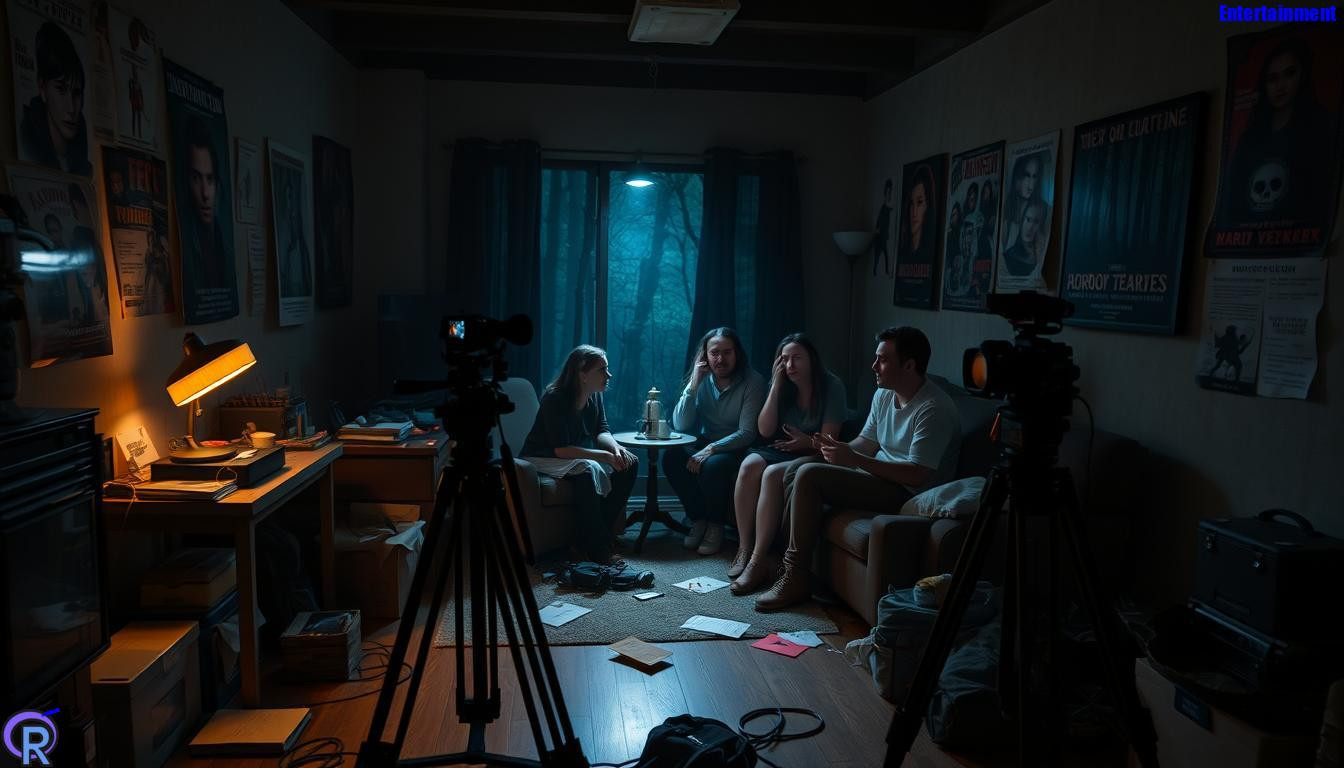The world of1 Found Footage Horror films mix reality and fiction in a unique way. This genre has grown from low budget to mainstream hits. Films like “The Blair Witch Project” and “Paranormal Activity”2 set the stage for this subgenre.
Found footage horror uses handheld cameras and first-person views. This makes the experience feel real and scary. It draws viewers into the story, making them feel the fear.
The genre has grown to include many subgenres and films from around the world. “REC”2 from Spain and “Noroi: The Curse”3 from Japan are just a few examples. These films show how found footage horror has become a key part of horror movies.
They mix realism with terror, keeping audiences hooked. This blend makes found footage horror a favorite among horror fans.
Key Takeaways
- Found footage horror films create a unique sense of authenticity and immersion through their use of handheld cameras and first-person perspectives.
- The genre has evolved from low-budget productions to mainstream success, with landmark films like “The Blair Witch Project” and “Paranormal Activity” paving the way.
- International contributions, such as the Spanish “REC” and the Japanese “Noroi: The Curse,” have expanded the genre’s reach and showcased its versatility.
- The genre’s ability to blur the line between reality and fiction has made it a staple of the horror landscape, captivating audiences with its unique approach to storytelling.
- Low-budget found footage horror films, like “Paranormal Activity”3 and “Hell House LLC,” have found success through their creative and innovative approaches to the genre.
The Evolution of Found Footage Horror: From Blair Witch to Modern Day
The found footage horror genre has grown a lot since The Blair Witch Project (1999). This film changed how horror movies were made and sold4. Made for just $60,000, it made over $250 million, showing its big potential4.
The Birth of a Genre: The Blair Witch Project
The Blair Witch Project used a new way of filming and marketing. It made people think the movie was real. This idea led to more found footage horror movies4.
Impact on Modern Horror Filmmaking
The Blair Witch Project’s success led to more found footage movies. Films like Paranormal Activity (2007) and V/H/S (2012) showed new ways to scare us4. These movies added to the found footage’s appeal as a scary storytelling method4.
Technology’s Role in Genre Development
New tech has changed found footage horror. Movies like Unfriended (2014) and Searching (2018) used video calls to feel real4. The pandemic helped too, with Host (2020) being made on Zoom4. These ideas keep the genre fresh and exciting4.
Starting with The Blair Witch Project, found footage has grown. It now includes many styles and themes, thanks to tech and what people like4. This genre keeps scaring us in new and exciting ways4.
Essential Elements of Found Footage Horror Movies
Found footage horror films use handheld cameras and shaky cam techniques to feel real. They also show raw, unpolished footage to look like amateur filmmaking5. The movies often have improvised dialogue and natural performances to seem more real5.
They use jump scares and build tension to scare the audience5. The movies are told as if they’re recovered evidence or live broadcasts gone wrong. This makes the horror experience more intense5.
The camera’s view, the characters’ POV, and the unseen threat are key to suspense6. The way the movie is framed adds to the mystery and surprise6. Cameras in the film make the characters’ need to document events more intense, adding to the voyeurism and fear6.
As technology improves, so does the found-footage horror genre6. Filmmakers find new ways to scare us, using cameras on phones and webcams6. They must explain why characters keep filming in danger, making the story more complex and engaging6.
The found footage horror genre has a long history, starting with Cannibal Holocaust (1980) and The Blair Witch Project (1999)5. Today, filmmakers keep finding new ways to scare us and draw us into their stories56.
| Film | Year | Significance |
|---|---|---|
| Cannibal Holocaust | 1980 | Credited with revolutionizing the found footage style of narrative filmmaking |
| America’s Deadliest Home Video | 1991 | Significant use of the found footage format within the horror/crime genre |
| The Blair Witch Project | 1999 | Popularized the found footage genre and became a commercial success |
“Found footage films have the potential to expand beyond horror into other genres in the future.”5
Found footage is cheap and easy to make, attracting film producers5. It lets them make horror movies on a small budget, thanks to its amateur look5.
The Lasting Impact of Found Footage Horror
Found footage horror has changed the film world, with classics like Cannibal Holocaust, The Blair Witch Project, and Paranormal Activity5. As tech advances and filmmakers explore new ideas, the future of found footage horror looks bright56.
The Blair Witch Project: Revolutionizing Horror Marketing
In 1999, “The Blair Witch Project” changed horror marketing forever with its viral campaign7. The film’s marketing made many think they were watching real footage8. This mix of fiction and reality, along with its documentary style, made the movie feel incredibly real8.
Viral Marketing Campaign Success
The marketing for “The Blair Witch Project” was a huge hit7. Made on a tiny budget of $60,0007, Artisan Entertainment paid $1.1 million for the rights at Sundance7. The total marketing spend was just $1.5 million7. Yet, the film’s website, blairwitch.com, got 3 million hits a day7.
The smart use of digital marketing, like the website and online communities, reached people when only 40% of U.S. homes had internet8.
Creating Authenticity Through Documentary Style
The Blair Witch Project’s filmmaking was key to its success8. The directors used real equipment to make the footage feel authentic8. The actors used their real names and improvised, adding to the film’s realistic feel8.
Impact on Pop Culture
“The Blair Witch Project” had a huge impact on pop culture7. It made nearly $250 million worldwide, starting in just 27 theaters7. Its profit was over 4,000 times its budget7. The marketing website had over 100,000 visitors before the film came out7.
This film was a game-changer in the found footage horror genre, changing how movies are marketed and experienced9.
“The Blair Witch Project” was a breakthrough success in the horror genre, demonstrating the power of viral marketing and audience immersion through its innovative documentary-style approach.
Paranormal Activity: Redefining Home Invasion Horror
In 2007, “Paranormal Activity” changed the game in supernatural horror10. Made for just $15,000, it showed that you don’t need a big budget to scare people10.
Oren Peli directed the film about a young couple, Katie and Micah, facing supernatural events in their home10. The film’s use of static shots and night-vision made it feel real, a hallmark of modern found-footage horror10.
The movie’s success led to a franchise lasting over 14 years, with six films from 2007 to 202110. The series spanned from 1988 to 2013, with different directors adding their own twist10.
The Paranormal Activity series scared audiences and shaped the found-footage horror genre10. It showed that you can scare people with a simple story and no fancy effects10.
“Paranormal Activity” had a huge impact on horror movies10. It changed the home invasion horror genre and helped found-footage horror grow in the digital age10. Its lasting popularity shows the strength of low-budget, character-driven horror stories.
International Found Footage Horror Gems
The found footage horror genre has reached fans all over the world. Filmmakers from Spain, Norway, Japan, and Taiwan have made their mark. They’ve brought new cultural views and creative ways to tell stories11.
[REC]: Spanish Horror Excellence
“[REC]” (2007) is a Spanish horror film that stands out. It mixes zombies and demons in a tight apartment. This makes for a scary and intense movie11.
Troll hunter: Nordic Folk Horror
“Troll hunter” (2010) from Norway is a mix of humor and fear. It uses Nordic stories in a mockumentary style. The film follows students who meet a troll hunter, making for a thrilling story11.
Noroi: Japanese Found Footage Mastery
“Noroi: The Curse” (2005) from Japan is known for its complex story and slow scares. It combines documentary, horror, and thriller elements. It’s a great start for those new to found footage11.
| Title | Country | Year | Director | Description |
|---|---|---|---|---|
| [REC] | Spain | 2007 | Jaume Balagueró, Paco Plaza | Blends zombie and demonic possession themes in a claustrophobic apartment setting. |
| Trollhunter | Norway | 2010 | André Øvredal | Incorporates Nordic folklore into a mockumentary format, creating a unique blend of humor and horror. |
| Noroi: The Curse | Japan | 2005 | Kōji Shiraishi | Demonstrates the genre’s ability to captivate audiences through a complex narrative structure and slow-building dread. |
These films show how the found footage genre can be diverse and scary. They mix different cultures, supernatural themes, and new ways to tell stories. This makes for unforgettable movies111213.
The Rise of Digital Age Horror: From VHS to Zoom
The found footage genre has changed a lot, moving from VHS tapes to digital formats. It now uses new techniques to grab the attention of today’s viewers. Digital horror, streaming horror, and zoom horror have made the genre stay fresh and exciting.
Films like “V/H/S” (2012) mix old and new, honoring the past while adding modern twists14. “Host” (2020) uses Zoom calls to create a creepy and real experience15.
The digital age has brought new ideas to horror movies. Now, we see social media and livestreaming in stories. This change keeps the genre alive and opens up new ways to tell scary tales.
“The found footage genre’s synchronicity with its time of production may lead to claims that its relevance diminishes over time, but it could also serve as a window into past societal relationships with media and technology.”
Today, filmmakers are exploring new ways to make horror feel real15. The rise of digital horror and streaming horror lets creators connect with a tech-savvy audience.
The found footage genre has grown from VHS tapes to today’s video calls. It shows how adaptable and strong it is. As tech keeps changing, the future of zoom horror and other digital horror looks very promising16.
Creative Approaches to Found Footage Horror
Found footage horror films are known for making reality and fiction blend together. They use creative methods to make the story feel real and scary. This genre keeps getting better, using new ways to scare us in documentary horror.
Documentary Style Techniques
“The Blair Witch Project” started the trend of using amateur videographers in found footage horror17. This makes the story feel more real and urgent. “Ghost watch” was so real it was banned from TV17.
More recent movies like “Lake Mungo” and “Noroi: The Curse” use the documentary style for their stories17.
Character-Driven Horror Elements
Some found footage horror films have been criticized for their characters17. But, some have made their characters more relatable. “Lake Mungo” and “The Conspiracy” added family drama and grief to their stories17.
“Creep” shows how scary human behavior can be17.
Sound Design and Jump Scares
The sound in found footage horror films is crucial. “Paranormal Activity” used quiet sounds to build tension and for jump scares17. “Cloverfield” made its monsters mysterious, using sound to scare us17.
Found footage horror is always changing. Filmmakers use new techniques, focus on characters, and create amazing soundscapes. These efforts keep audiences hooked and redefine documentary horror.
| Film | Budget | Rotten Tomatoes Rating |
|---|---|---|
| Creep | Less than $500 | N/A |
| Paranormal Activity (Franchise) | $15,000 to $10 million | 83% to 15% |
| Unfriended | Over $1 million | N/A |
Successful found footage horror films often have low budgets18. “Creep” was made cheaply but is highly praised for its scares18. But, bigger-budget films like “Unfriended” can’t match the real feel of the genre18.
“The Blair Witch Project” was released in 1999, contributing to the popularization of the found footage horror genre19.
As the genre grows, filmmakers keep finding new ways to scare us. They use documentary styles, focus on characters, and create amazing sounds. The future of documentary horror looks bright and full of possibilities171918.
Low Budget Success Stories in Found Footage Horror
The found footage horror genre has seen many low-budget success stories20. “The Blair Witch Project” is a prime example, made for just $35,000-60,00021. It became a huge hit, earning over $240 million worldwide.
“Paranormal Activity” is another success story, made for $230,000 but earning over $200 million globally21. These films show that low-budget horror can be very profitable, encouraging more indie filmmakers to try the found footage style.
“Project Eerie” is a great example of indie success in found footage horror20. It’s a 76-minute anthology that focuses on storytelling and effects, not big budgets. The first story, about a father-daughter camping trip, is widely praised.
Independent filmmakers in found footage horror have shown incredible resilience and creativity2021. These success stories prove the genre’s commercial potential. They also show that great horror can be made with limited resources and a focus on storytelling.
“The Blair Witch Project” (1999) and “Paranormal Activity” (2007) have shown that found footage horror can deliver impressive returns on a shoestring budget, paving the way for a new generation of indie filmmakers to explore the genre’s full potential.
Psychological Impact and Viewer Immersion
Found footage horror films grab viewers and pull them into the story. They use a first-person view and a documentary style. This makes the experience feel real and can stir strong emotions22.
The acting in these films, often by unknown actors, can affect how well we get lost in the story22. Scenes that are disturbing or graphic can also change how we feel and how much we’re drawn into the movie22.
Research shows that stories told in real-time, like in movies and games, make us feel more involved22. This feeling can make us feel more scared, as seen in VR gaming23. Being connected to the characters on screen makes the fear feel more real.
But found footage horror does more than just scare us. It can change how we see time, especially if we’ve experienced trauma22. The low cost of making these films makes them feel like real documentaries or home videos24. These movies keep drawing us in, making us think and feel deeply.
FAQ
What is the found footage horror genre?
Found footage horror films mix reality and fiction in a unique way. They use handheld cameras and first-person views to make the experience feel real. This makes the scares even more intense.
How has the found footage genre evolved over time?
The genre started with low-budget films but has grown big. Movies like “The Blair Witch Project” and “Paranormal Activity” helped it grow. Now, it includes many subgenres and films from around the world.
What are the key elements of found footage horror films?
These films use handheld cameras and shaky footage to feel real. They also have raw, unpolished looks and natural acting. Jump scares and tension are used to scare the audience.
How did “The Blair Witch Project” revolutionize horror marketing?
“The Blair Witch Project” changed horror marketing with its viral campaign. It made people think they were watching real footage. This mix of fiction and reality made the film very engaging.
How did “Paranormal Activity” redefine the home invasion horror subgenre?
“Paranormal Activity” changed home invasion horror with its simple yet scary approach. It was made on a low budget but scared many with its realistic portrayal of supernatural events. Its use of static shots and night-vision added to its unique style.
What are some notable international found footage horror films?
International films like “[REC]” from Spain and “Trollhunter” from Norway are notable. They mix different themes and styles, showing the genre’s global appeal. “Noroi: The Curse” from Japan is also known for its complex story and slow build-up of fear.
How has the found footage genre evolved with technology?
The genre has grown with technology, from VHS to digital. Films like “V/H/S” mix old and new themes. “Host” uses video calls to scare, showing how tech can be used in horror.
What are some of the creative techniques used in found footage horror films?
These films use many creative ways to scare and feel real. They often use documentary styles and focus on characters. Sound design is key in creating atmosphere and jump scares.
What are some examples of low budget found footage horror success stories?
Films like “Paranormal Activity” and “The Blair Witch Project” were made cheaply but made a lot of money. This shows the genre’s potential for big returns on small budgets, encouraging indie filmmakers.
How do found footage horror films impact viewers psychologically?
These films can deeply affect viewers because they feel real. The first-person view and documentary style make fear and anxiety stronger. This makes the experience more intense and personal.
Source Links
- https://collider.com/found-footage-horror-movies-guide/ – A Guide to Found Footage Horror Movies, From Beginner to Expert
- https://3brothersfilm.com/blog/2017/10/halloween-horror-a-viewers-guide-to-found-footage – Halloween Horror: A Viewer’s Guide to Found Footage — 3 Brothers Film
- https://creepybonfire.com/horrortainment/tv-and-films/11-found-footage-horror-films-to-watch-in-the-dark/ – 11 Found Footage Horror Films to Watch in the Dark
- https://screenrant.com/found-footage-horror-movies-blair-witch-evolution-explained/ – How Found Footage Horror Movies Have Evolved Since The Blair Witch Project
- https://en.wikipedia.org/wiki/Found_footage_(film_technique) – Found footage (film technique)
- https://medium.com/@TheFilmJournal/the-intelligence-of-found-footage-horror-956ce230f362 – The Intelligence of ‘Found-Footage’ Horror
- https://www.latimes.com/entertainment-arts/movies/story/2024-07-30/the-blair-witch-project-marketing-25th-anniversary-1999-project – How ‘The Blair Witch Project’ revolutionized movie marketing
- https://www.mainstreethost.com/blog/how-the-blair-witch-project-revolutionized-marketing/ – How The Blair Witch Project Revolutionized Marketing
- https://studentfilmreviews.org/?p=36579 – Student Film Reviews » Blog Archive » The Blair Witch Project: The Marketability of Reality
- https://www.cbr.com/paranormal-activity-watch-order/ – How To Watch The Paranormal Activity Movies Order
- https://movieweb.com/international-found-footage-horror-movies/ – Best International Found Footage Horror Movies You Need to Watch Next
- https://collider.com/found-footage-movies-international-best-ranked/ – The 15 Best International Found Footage Movies, Ranked
- https://www.vulture.com/article/best-found-footage-horror-movies.html – The 25 Best Found-Footage Horror Movies
- https://www.empireonline.com/movies/features/found-footage-horror-a-history-in-20-movies/ – Found Footage Horror: A History In 20 Movies
- https://www.horrorhomeroom.com/if-you-are-watching-this-tape-found-footage-horror-as-archival-record/ – ‘If you are watching this tape…’: Found Footage Horror as Archival Record – Horror Movie – Horror Homeroom
- https://epublications.regis.edu/cgi/viewcontent.cgi?article=2082&context=theses – FROM TV TO TIKTOK: WHAT TECHNOLOGY IN HORROR FILM SHOWS ABOUT SOCIETY’S SHIFTING FEARS
- https://thescriptlab.com/features/main/7525-art-writing-horror-found-footage-done-right/ – The Art of Writing Horror: Found Footage Done Right – The Script Lab
- https://tsl.news/horror-hour-the-found-footage-phenomenon-in-creep/ – Horror Hour: The found footage phenomenon in “Creep” – The Student Life
- https://medium.com/@sophieshear/the-art-of-a-convincing-found-footage-film-458060291dd9 – The Art of a Convincing Found Footage Film
- https://www.comicsbeat.com/horror-beat-project-eerie/ – HORROR BEAT: PROJECT EERIE captures great found footage horror on a budget
- https://www.bradleyscout.com/voice/35720/ – The rise and fall of found footage horror – The Bradley Scout
- https://medium.com/@nikkiflausch/of-immersion-and-found-footage-in-art-8f724ecbdeaf – Of Immersion and Found Footage in Art
- https://d-nb.info/124323041X/34 – Fear and loathing in VR: the emotional and physiological effects of immersive games
- https://radar.brookes.ac.uk/radar/items/acec9651-8bb1-4df3-9c00-6f800a34566d/1/viewcontent/79d5031c-2e52-4b40-8ba2-32b1e6f55e19?event__=newtree.viewNode&eventp__0=uid1 – 9781138388512.indb






